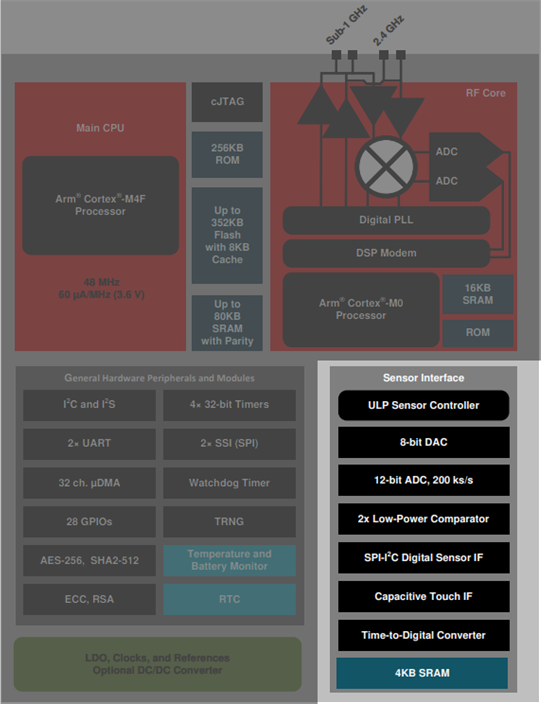SWRA578B October 2017 – April 2020 CC1312PSIP , CC1312R , CC1314R10 , CC1352P , CC1352P7 , CC1352R , CC2620 , CC2630 , CC2640 , CC2640R2F-Q1 , CC2642R , CC2642R-Q1 , CC2650MODA , CC2652P , CC2652R , CC2652R7 , CC2652RB , CC2652RSIP
1 Overview
The CC13x2/CC26x2 devices comes equipped with a separate proprietary power-optimized CPU called the Sensor Controller. This CPU can read and monitor sensors or perform other tasks autonomously; thereby significantly reducing power consumption and offloading the system CPU.
 Figure 1. CC13x2/CC26x2 System Block Diagram
Figure 1. CC13x2/CC26x2 System Block Diagram
The CC13x2/CC26x2 Sensor Controller peripherals include:
- 12-bit ADC capable of sampling analog capable I/Os or internal chip voltages.
- Two comparators, one high performance continuous time comparator and one low-power clocked comparator updated at 32 kHz.
- 8-bit reference DAC capable of supporting the comparators with reference voltages.
- SPI master interface.
- Bit-banged interfaces including I2C master, LCD controller and more.
- Time to digital converter capable of measuring the time between configurable start and stop triggers
- Programmable current source capable of giving out currents between 0 and 20 µA.
- Two simple 16-bit timers.
- 16-bit asynchronous multipurpose timer with 4 capture/compare channels.
- 16-bit pulse counter capable of count rising edges on any digital input pins or comparator output.
- Access to all GPIO pins.
The Sensor Controller can be programmed from the software Sensor Controller Studio. This tool generates a Sensor Controller Interface driver, which is a set of C source files to be compiled into the System CPU application. These source files contain the Sensor Controller firmware image and associated definitions, and generic functions that allow the System CPU application to control the Sensor Controller and exchange data. Full documentation on how to use the Sensor Controller is documented in the Sensor Controller Studio itself.
The programming model and firmware framework are optimized for low overhead when communicating with the System CPU application, low AUX RAM memory footprint, and efficient use of the Sensor Controller's instruction set. To minimize power consumption, the Sensor Controller enters standby mode automatically when it is idle.